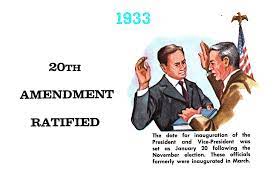The 20th Amendment to the United States Constitution, ratified on January 23, 1933, marked a significant moment in the nation's history by addressing the issues surrounding the inauguration date of the President and the convening of Congress. Commonly known as the "Lame Duck Amendment," this constitutional amendment aimed to reduce the lengthy period between a presidential election and the inauguration, thereby enhancing the efficiency and responsiveness of the federal government. Before the adoption of the 20th Amendment, the presidential term began on March 4, a timeline established in the 12th Amendment. However, this created a considerable gap between Election Day in November and the incoming president's assumption of office. During this interim period, outgoing administrations, often referred to as "lame ducks," had limited accountability and authority, potentially leaving the country without effective leadership in times of crisis. The delay between election and inauguration also impeded the federal government's ability to respond swiftly to pressing issues. This was particularly evident during the economic hardships of the Great Depression, as the outgoing President Herbert Hoover struggled to address the worsening economic conditions during the months between his electoral defeat in 1932 and Franklin D. Roosevelt's inauguration in March 1933. The 20th Amendment sought to rectify these issues by shortening the transition period. It changed the presidential inauguration date from March 4 to January 20, aligning with the start of the new congressional session. Additionally, the amendment mandated that Congress must convene on January 3, unless they pass a law designating a different date. This synchronization aimed to reduce the time between the election and the swearing-in of the new president, ensuring a more immediate transfer of power and responsiveness to national challenges. The amendment also addressed the potential incapacitation of a president-elect before inauguration. In the event of a president-elect's death or inability to assume office, the vice president-elect would now take the oath of office, maintaining continuity in leadership. The 20th Amendment not only modernized the presidential transition process but also brought about a more effective and responsive government. By shortening the "lame duck" period, the amendment sought to prevent outgoing administrations from making significant policy decisions without the public's current mandate. It aimed to ensure that the elected leaders would assume office promptly, equipped with a fresh mandate and the ability to address the nation's immediate concerns. The ratification of the 20th Amendment reflected a broader understanding of the need for a more agile and accountable government, particularly in times of crisis. The amendment remains a testament to the Founding Fathers' adaptability in recognizing and rectifying deficiencies in the Constitution to uphold the principles of democracy and provide for the efficient functioning of the federal government.
23 january 1933 20th Amendment To The Constitution
